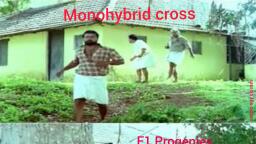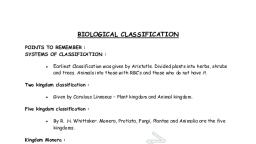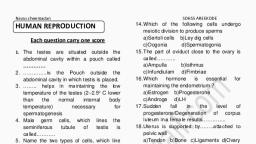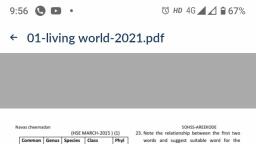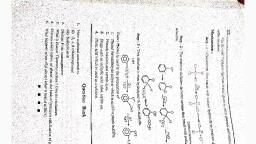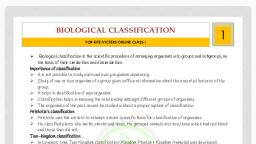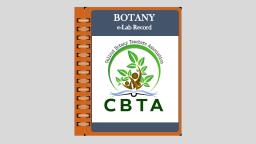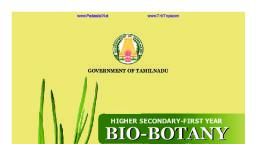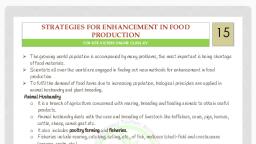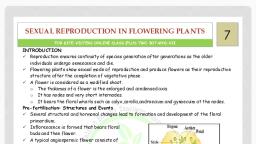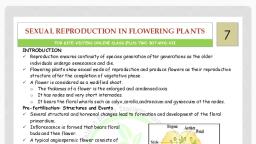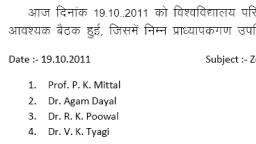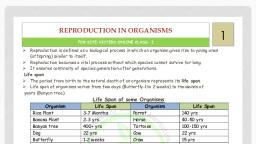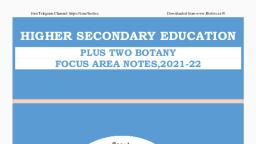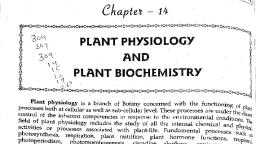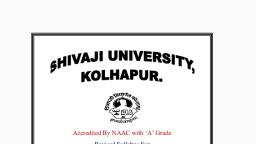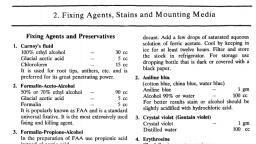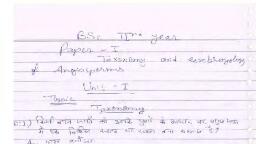Page 1 :
BOTANY, e-Lab Record
Page 2 :
HIGHER SECONDARY COURSE, KKM GOVT.HSS ORKATTERI, , BOTANY PRACTICAL RECORD, Reg.Number............................, BOTANY, Prepared by, , Ismail Parambath, KKM Govt.HSS Orkatteri, Kozhikkode., Mobile. 9847952446, , Name ……………………………..……………….………, Class ………………… .............Batch…….……....., Roll No………………….. Year ….……..…………....., I certified that this is the bonafide record of, practical work done by................................................in, the botany lab during..................with register, .number........................, , Date.................., Examiner.................., , Teacher in Charge
Page 6 :
BACTERIA, Systematic Position, , Identification, The given specimen is Bacteria –, Lactobacillus, , Kingdom : Monera, Group : Eubacteria, Strain : Lactobacillus, balgaricus, , Reason for Idenification, , I t is r o d shaped bacteria, f o u n d i n curd., I t is a p r o k a r y o t i c monera., I t reproduces by b i n a r y, fission, , Bacteria, , Prepared by Ismail Parambath,KKM Govt.HSS,Orkatteri
Page 10 :
LICHEN-USNEA, Systematic Position, , Identification, The given specimen is Usnea, with apothecium., , Reason for Identification, , Kingdom, Division, Class, Order, Family, Genus, Species, , : Fungi, : Lichen, : Ascolichen, : Usnialess, : Usniaceae, : Usnea, : aspera, , Lichen is a s y m b i o t i c, association of fu ngi a n d, algae., Fungal p a r t n e r is called, m y c o b i o n t a n d t h e algal, p a r t n e r is called phycobiont., Reproductive bodies are disc, shaped apothecia seen a t t h e, t i p of branches., , Prepared by Ismail Parambath,KKM Govt.HSS,Orkatteri
Page 12 :
SPIROGYRA, Systematic Position, , Identification, The given specimen is, Spirogyra filament., , Kingdom, Division, Class, Order, Family, Genus, Species, , :, :, :, :, :, :, :, , Plantae, Chlorophyta, Chlorophyceace, Conjugales, Zygnemaceae, Spirogyra, maxima, , Reason for Identification, S p i r o g y r a is a filamentous, fresh w a t e r, green algae., Each cell consists of a, r i bbo n shaped spirally, a r r a n g e d chloroplast., The f i l a m e n t is un branched., , Prepared by Ismail Parambath,KKM Govt.HSS,Orkatteri
Page 13 :
SARGASSUM, Systematic Position, , Identification, The given specimen is, Sargassum thallus., , Kingdom, Division, Class, Order, Family, Genus, Species, , :, :, :, :, :, :, :, , Plantae, Phaeophyta, Phaeophyceace, Fucales, Sargassaceae, Sargassum, cinereum, , Reason for Identification, I t is a b r o w n algae., The p l a n t body consists of, hold fast, p r i m a r y, l a t e r a l , secondary, l a t e r a l , a i r bl a d d er a n d, receptacles., Receptacles are s h o r t, reproductive, branches., , Prepared by Ismail Parambath,KKM Govt.HSS,Orkatteri
Page 15 :
MOSS PROTONEMA, Systematic Position, , Identification, The given specimen is Moss, protonema., , Kingdom, Division, Class, Order, Family, Genus, Species, , :, :, :, :, :, :, :, , Plantae, Bryophyta, Bryopsida, Funariales, Funariaceae, Funaria, hygrometrica, , Reason for Identification, P r o t o n e m a is green,, multicellular, autotrophic,, branched filamentous, structure., Rhizoids are produced f r o m, t h e l o w e r side w h i c h serve, f o r f i x a t i o n a n d absorption, ., , Prepared by Ismail Parambath,KKM Govt.HSS,Orkatteri
Page 17 :
PINUS MALE CONE, Systematic Position, , Identification, The given specimen is Pinus, Male Cone., , Kingdom, Division, Class, Order, Family, Genus, Species, , :, :, :, :, :, :, :, , Plantae, Gymnosperm, Coniferopsida, Coniferales, Pinaceae, Pinus, roxburghii, , Reason for Identification, , I t consists of a n axis,, a n d microsporophylls, are a r r a n g e d spirally, on i t, Each m i cro s p o ro p h y l l bears, t w o small microsporangia on, t h e l o w e r side., Each m i c r o s p o r a n g i u m, contains pollen grains. The, pollen grains are winged, , Prepared by Ismail Parambath,KKM Govt.HSS,Orkatteri
Page 20 :
RHIZOME - GINGER, Under ground stem, modification, 1. Rhizome, , Reason for Identification, , I t grows h o r i z o n t a l l y u n d e r, t h e soil, I t has nodes, internodes, scale, leaf, a x i l l a ry bud, t e r m i n a l, bud a n d adventitious roots, I t is t h i c k a n d fleshy due, t o food storage, , Prepared by Ismail Parambath,KKM Govt.HSS,Orkatteri
Page 21 :
STEM TUBER - POTATO, Under ground stem, modification, 2. Potato -Stem tuber, , Reason for Identification, , The t i p of u n d e r g r o u n d, l a t e r a l branches m o d i f i e d t o, swollen fleshy tubers due t o, food storage, A d v e n t i t i o u s roots,, a x i l l a r y buds a n d scale, leaves are developed a t t h e, nodal p o r t i o n, Nodes are represented by, small depression called ‘eyes ‘of, potato, , Eye, , Prepared by Ismail Parambath,KKM Govt.HSS,Orkatteri
Page 22 :
BULB - ONION, Under ground stem, modification, 3. Bulb, , Reason for Identification, , S t e m is highly reduced i n t o, a disc like s t r u c t u r e, The leaves are m o d i f i e d i n t o, t h i c k a n d fleshy due t o t h e, storage of food m a t e ri a l s, , Prepared by Ismail Parambath,KKM Govt.HSS,Orkatteri
Page 23 :
RUNNER - CENTELLA, , Sub aerial stem Modification, 1. Runner, , Reason for Identification, It is creeper with long and, slender internodes., Runner grows horizontally, on the soil surface and, helps in vegetative, propagation., , Runner, , Prepared by Ismail Parambath,KKM Govt.HSS,Orkatteri
Page 24 :
OFFSET -EICHHORNIA, Sub aerial stem Modification, 2. Offset, , Reason for Identification, , Offset is type runner with, short,stout and thick, internode, It helps in vegetative, propagation., , Prepared by Ismail Parambath,KKM Govt.HSS,Orkatteri
Page 30 :
DICOT STEM, , Reason for Identification, 1. Vascular bundles are, conjoint and collateral., 2. Xylem is endarch., 3. Cortex is heterogeneous., .....hence it is a stem., , Diagramatic view, , A Portion enlarged, , 1. Vascular bundles are, limited in number., 2. Vascular bundles are, arranged in broken ring, manner., 3. Vascular bundles are open., ......hence it is a dicot stem, , Prepared by Ismail Parambath,KKM Govt.HSS,Orkatteri
Page 31 :
Reason for Identification, 1. Vascular bundles are, conjoint and collateral., 2. Xylem is endarch., ......hence it is a stem., , MONOCOT STEM, , Diagramatic view, , A Portion enlarged, , 1. Vascular bundles are, numerous and scattered in, ground tissue., 2. Vascular bundles are, closed, 3. Homogenous ground tissue, ……………………………..hence it is a, monocot stem, Prepared by Ismail Parambath,KKM Govt.HSS,Orkatteri
Page 32 :
DICOT ROOT, , Reason for Identification, , 11. Vascular bundles are, radial., 2. Xylem is exarch., 3. Cortex is homogenous., .....hence it is a root., 1. Xylem and phloem groups, are limited in number., 2. Pith is reduced or absent., 3. polygonal xylem., ......hence it is a dicot root, , Diagramatic view, , A Portion enlarged, , Prepared by Ismail Parambath,KKM Govt.HSS,Orkatteri
Page 33 :
MONOCOT ROOT, , Reason for Identification, , 1. Vascular bundles are, radial., 2. Xylem is exarch., 3. Cortex is, homogenous......hence it is a, root., 1. Xylem and phloem groups, are numerous in number., 2. Pith is large, 3. Round or oval outline of, xylem., ......hence it is a monocot root, , Diagrammatic view, , A Portion enlarged, , Prepared by Ismail Parambath,KKM Govt.HSS,Orkatteri
Page 41 :
CLONING VECTOR, , Reason for, Identification, 1. They are the, carriers used to, introduce a, foreign gene into a host, organism., 2. Most commonly used, plasmid vector is pBR, 322, ., Prepared by Ismail Parambath,KKM Govt.HSS,Orkatteri
Page 42 :
BIO REACTOR, , Reason for, Identification, 1. It is large vessel used, to produce specific, products, enzymes, 2.Raw materials are, biologically converted, into useful, products, , Prepared by Ismail Parambath,KKM Govt.HSS,Orkatteri
Page 44 :
MUTUALISM-LICHEN, Reason for Identification, Mutualism is the, interaction between two, organisms in which both, the partners are, benefited. (+ + )., Lichen is the association, of fungi and algae., Fungal partner is called, Mycobiont and the algal, partner is called, Phycobiont., , Prepared by Ismail Parambath,KKM Govt.HSS,Orkatteri
Page 45 :
COMMENSALISM/EPIPHYTE, Reason for Identification, Commensalism is the, interaction between two, organisms in which one, gets benefit and the, other neither gets, benefit or harm.( +, 0), Vanda is an Epiphyte., It grows on other plants, only for support/space., It does not take, nutrients and water, from the host,, , Prepared by Ismail Parambath,KKM Govt.HSS,Orkatteri
Page 46 :
PARASITISM-CUSCUTA, , Reason for Identification, I t is an example for, parasitism., Parasitism is the, interaction between, t w o organisms in which, one/parasite gets, benefit and the, other/host is harmed, ( + - )., Cuscuta is a t o t al, stem parasite, , Prepared by Ismail Parambath,KKM Govt.HSS,Orkatteri
Page 48 :
STUDY OF OSMOSIS BY THISTLE, FUNNEL EXPERIMENT, , Aim :, To demonstrate osmosis by using, thistle funnel, experiment., Materials required,, Egg membrane, beaker, water,, string, sugar solution, Glass thistle, funnel, stand etc., Procedure:, A glass thistle funnel is taken and, its wide mouth is closed tightly with, an egg membrane. Through the, narrow stem of thistle funnel a, strong solution of sugar is carefully, poured into it, till its level has, reached a little above the neck, portion. The mouth of thistle, funnel is allowed to dip in water., Prepared by Ismail Parambath,KKM Govt.HSS,Orkatteri
Page 49 :
Observation :, The level of the sugar solution in, the thistle funnel rises up., Inference:, This rise in level of sugar, solution in thistle, funnel is due to the increase in, osmotic pressure of sugar solution, than that of water in the beaker., Therefore, water molecules rapidly, diffuse from the beaker into the, thistle funnel through the egg, membrane. Since this diffusion of, water takes place through a semi, permeable membrane, it is called, osmosis., , ., , Prepared by Ismail Parambath,KKM Govt.HSS,Orkatteri
Page 50 :
STUDY OF IMBIBITION BY, RAISINS, Aim: To study the phenomenon, of imbibition by raisins., Materials required:, Raisin s,pet r i d ishes,Water, etc, Principle :, This is t h e absorption of w a ter, molecule by in soluble an d, hyd r ophilic cell wall, constituents w i t h o u t f o r m i n g, a solution, Procedure: Take a petridish and, place a few r a isin s in i t Take, another p e t r i d ish, con taining w ater and also place, a few r a isin s in i t . Keep, the, p e t r i d ish un d istur bed f o r 3, t o 6 hours.., Prepared by Ismail Parambath,KKM Govt.HSS,Orkatteri
Page 51 :
Observation:, The raisins placed in the, petridish containing w a t e r wil l, swell up.The raisins placed in, the petridsh w i t h o u t w a t e r, remains as such., Inference:, The raisins swell, up due t o, imbibition, of, water., The, hydrophilic colloids present in, the f r u i t, wall of raisins, absorb water., , Prepared by Ismail Parambath,KKM Govt.HSS,Orkatteri
Page 52 :
GANONG’S POTOMETER, Aim: To measure the rate of, transpiration by using Ganong’s, potometer., Materials required:, Ganong’s, potometer, a fresh, plant twig, beaker, water, etc., Procedure:, The instrument used to measure, the rate of, transpiration is, known as Ganong’s potometer. It, consists, of, a, graduated, horizontal capillary tube, one, end of which is curved upwards, with a wide mouth provided, with holed cork. The other end, of the capillary tube is bent, downwards with and it opens, outside by small pore., , Prepared by Ismail Parambath,KKM Govt.HSS,Orkatteri
Page 53 :
A reservoir is attached to the, capillary tube through a stop cock., The end of the capillary tube is, dipped into coloured solution in a, beaker. The whole apparatus rests on, a stand. The apparatus is filled with, water by opening the stop- cock of, the reservoir. Afresh leafy twig of a, plant is cut under water and is, introduced through the one holed, cork so that the cut end of the twig, dipped in water. All the fittings are, made air tight by applying Vaseline., The stop-cock is now closed. If the, whole set up is air tight, water will, not flow down through the pore of, the capillary tube. A small air bubble, is allowed to enter the capillary tube, by means of a cotton plug., , Prepared by Ismail Parambath,KKM Govt.HSS,Orkatteri
Page 54 :
Observations: The air bubble is, kept at the zero mark of the, capillary tube: As transpiration, proceeds, the bubble moves, through the horizontal, graduated capillary tube. The, time taken by the air bubble to, move from the zero mark to a, particular distance in the, capillary tube is noted. Then the, instrument is placed in, different environmental, conditions and the time taken, by the air bubble to cover the, same distance is noted and the, rate of transpiration is, determined., Inference:The rate of movement of, air bubble in unit time indicates the, rate of transpiration., Prepared by Ismail Parambath,KKM Govt.HSS,Orkatteri
Page 55 :
HYDRILLA EXPERIMENT, Aim :, To study evolution of oxygen during, photosynthesis., Materials required: A few branches, of tfydrilla plant, sodium bicarbonate, (NatfCO3), a graduated beaker,, water a glass funnel, a test tube, etc., Procedure: 2 gm of sodium, bicarbonate is dissolved in 10 ml of, distilled water . 2 ml of this water, contains 0.4 grams of sodium, bicarbonate. 100 ml of Water is, taken in a graduated beaker. A few, branches of tfydrilla are placed in a, beaker. Cut the bases of the, branches of hydrilla, tie them with, thread and cover them with an, inverted glass funnel, in such a, fashion that the, Prepared by Ismail Parambath,KKM Govt.HSS,Orkatteri
Page 56 :
cut ends of the plants are towards, the neck of the funnel. The funnel is, completely under water. A test tube, filled with water is inverted over the, tail of the funnel. The whole, apparatus is kept in sunlight and, observed for sometime., Observation:, Small air bubbles come out, continuously from the cut ends of, tfydrilla and they are collected at, the top of the test tube by down, ward displacement of water. On, testing this gas, it is found to be, oxygen., Inference:, From this experiment we can infer, that the branches of Hydrilla carried, on photosynthesis and liberated, oxygen., Prepared by Ismail Parambath,KKM Govt.HSS,Orkatteri
Page 57 :
STUDY OF PLANT PIGMENTS, BY PAPER CHROMATOGRAPHY, Aim:, To separate the photosynthetic, pigments, by, Unidirectional, paper chromatography., Materials required:, Petroleum, ether,, acetone,, Watman, No. 1 filter paper,, glass rod, measuring jar, split, cork, leaf extract etc., Procedure : 2 m l of running, solvent (petroleum ether and, acetone in 9 : 1 ratio) is taken in, a large, measuring jar. I t is, closed tightly w i t h a split cork., A long strip of Wat man No;.l, filter paper is taken and is cut, at one end to get ‘V’ shaped tip., , Prepared by Ismail Parambath,KKM Govt.HSS,Orkatteria
Page 58 :
A pencil line is drawn about 2cm, above the tip and central point of, it is marked as origin. Leaf extract, is prepared by grinding green, leaves with acetone. The leaf, extract is applied at the marked, region of filter paper. A plenty of, pigments are applied on the filter, paper and the spot should be less, than 0.5 cm diameter. The lower, end of the filter paper is dipped in, the solution and upper end is fixed, in the split cork in the jar., Observation: The pigments of the, extract get separated because of, their differential solubility in a, moving phase. The lower most layer, is chlorophyll ‘b’ (yellow green),, then chlorophyll ‘a’ (blue green),, xanthophyll(yellow green) and, carotene(orange red) respectively., Prepared by Ismail Parambath,KKM Govt.HSS,Orkatteri


